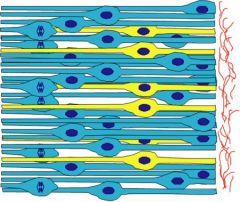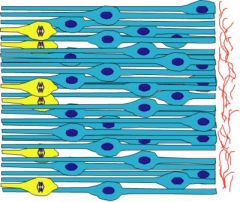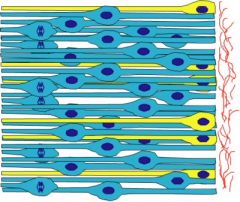![]()
![]()
![]()
Use LEFT and RIGHT arrow keys to navigate between flashcards;
Use UP and DOWN arrow keys to flip the card;
H to show hint;
A reads text to speech;
85 Cards in this Set
- Front
- Back
|
At what week does neurulation occur in the fetus?
|
Week 4
|
|
|
What type of epithelium surrounds the central canal of the neural tube?
|
neuroepithelium (a pseudostratified epithelium)
|
|
|
What occurs in the neuroepithelium?
|
Cell Division (contains cells at different stages in mitosis)
|
|
|
Where are cells in the S and M phases of mitosis found (in reference to the central canal)?
|
S phase --> farther from the central
M phase --> closest to the central canal |
|
|
In Neurulation:
chordin, noggin and sonic hedgehog mediate the formation of _______________? |
neuroectoderm
|
|
|
Describe primary neurulation
|
neural tube forms (by folding of the neural plate)
|
|
|
Describe secondary neurulation
|
Recanalization of a cord of mesenchyme to form the neural tube
|
|
|
After closure of the neural tube the anterior and posterior neuropores close. Which one closes first?
|
anterior (closes 1 day prior to posterior)
|
|
|
Where does closure of the neural tube begin?
|
midway along its length (then "zippers" caudally and rostrally)
|
|
|
Summarize the 5 major stages in neurulation
|
1. formation of neuroectoderm
2. primary neurulation 3. secondary neurulation 4. neural tube closure 5. subdivision into brain and spinal cord |
|
|
Cellular differentiation in the neuroepithelium gives rise to 3 zones: what are they?
|
1. ventricular
2. intermediate 3. marginal |
|
|
The _________ layer of the neuroepithelium is the site of mitosis.
|
Ventricular (layer)
|
|
|
The __________ layer of the neuroepithelium develops into the gray matter of the mature spinal cord.
|
Intermediate (layer)
|
|
|
The ___________ layer of the neuroepithelium differentiates into the white matter of the mature spinal cord.
|
Marginal (layer)
|
|
|
The alar and basal plates are separated by the ________.
|
Sulcus limitans
|
|
|
the alar plate is associated with _________ (motor/sensory)functions, white the basal plate is associated with ___________ (motor/sensory) functions.
|
1. sensory; becomes the gray matter of dorsal horn
2. motor; becomes the gray matter of the ventral horn |
|
|
3 essentials for dorsal-ventral patterning of the spinal cord:
|
1. floor plate
2. BMP 3. Shh |
|
|
In dorsal-ventral patterning of the spinal cord:
Shh is secreted by ________. Function of Shh? |
floorplate cells
induces formation of ventral motorneurons |
|
|
In dorsal-ventral patterning of the spinal cord:
BMP induces the formation of __________? |
interneurons
|
|
|
The neural crest arises from ___________ lying at the crest of the neural folds.
|
neuroectoderm
|
|
|
what are the 4 neural crest subdivisions?
|
1. cranial neural crest
2. cardiac neural crest 3. trunk neural crest 4. vagal/sacral neural crest |
|
|
The following are derivatives of which portion of neural crest?
craniofacial mesenchyme pharyngeal arches |
Cranial neural crest
|
|
|
The following are derivatives of which portion of neural crest?
endothelium of aortic arches aorta/pulmonary artery septum |
Cardiac neural crest
|
|
|
The following are derivatives of which portion of neural crest?
melanocytes dorsal root ganglia sympathetic ganglia adrenal medulla |
Trunk neural crest
|
|
|
The following is a derivative of which portion of neural crest?
parasympathetic ganglia of gut |
Vagal/sacral neural crest
|
|
|
What directs migration of the cells of the neural crest? (3)
|
1. extracellular matrix composition
2. cell adhesion molecules (ie. integrins) 3. growth factors |
|
|
neurons of the PNS are derived from neuroepithelium on the __________.
|
neural crest
|
|
|
Where do neurons of the SYMPATHETIC nervous system leave the spinal cord? They leave via the ______________ (ventral/dorsal) root.
|
T1 - L2
leave via the ventral root |
|
|
The neural crest gives rise to what portion of the sympathetic and parasympathetic nervous systems?
|
gives rise to the postganglionic neurons of the sympathetic and parasympathetic nervous systems.
|
|
|
Where do neurons of the PARASYMPATHETIC nervous system leave the spinal cord?
|
S2 - S4
|
|
|
The ventricles are derived from the ______________?
|
neural tube lumen
|
|
|
The alar plate ultimately gives rise to ___ (#) nuclei and they are all _________. (afferent/efferent)
|
4 nuclei
all afferent |
|
|
The basal plate ultimately gives rise to ___ (#) nuclei and they are all _________. (afferent/efferent)
|
3 nuclei
all efferent |
|
|
The forebrain (prosencephalon) gives rise to the _________ and ________
|
telencephalon
diencephalon |
|
|
"Contents" of the telencephalon?
|
lateral ventricles
cerebral hemispheres |
|
|
"Contents" of the diencephalon?
|
thalamus (+assoc. structures)
third ventricle |
|
|
The mesencephalon gives rise to _____________.
|
nothing. It remains mesencephalon.
|
|
|
"contents" of the mesencephalon?
|
midbrain
cerebral aqueduct |
|
|
The hindbrain gives rise to __________ and _____________.
|
metencephalon (rostral)
myelencephalon (caudal) |
|
|
"contents" of the metencephalon?
|
Pons
Cerebellum Upper part of 4th ventricle |
|
|
"contents" of the myelencephalon?
|
medulla
Lower part of 4th ventricle |
|
|
The alar plate of the myelencephalon gives rise to 4 caudal nuclei. Name them.
|
1. Gracile nucleus
2. Cuneate nucleus 3. Spinal Trigeminal nucleus (CN V) 4. Olivary nucleus |
|
|
What does the olivary nucleus contain?
|
contains cerebellar relay nuclei
|
|
|
The alar plate of the myelencephalon gives rise to 4 rostral nuclei. Name them.
|
1. vestibulocochlear nucleus
(CN VIII) 2. spinal trigeminal nucleus (CN V) 3. Solitary nucleus (CN VII, IX, X) 4. olivary nucleus |
|
|
The basal plate gives rise to 3 nuclei. Name them.
|
1. dorsal motor nucleus of CN X/inferior salivatory nucleus of CN IX
2. nucleus ambiguus (CN IX, X, XI) 3. Hypoglossal nucleus (CN XII) |
|
|
the telia choroidea and choroid plexus can be found _____________.
|
At the roofplate
|
|
|
Where would the pontine nucleus be found and what is it's function?
|
found in the Pons
function - cerebellar relay |
|
|
Describe the development of the cerebellum (General)
|
cerebellum--> from alar plate
dorsal part of alar plate gives rise to rhombic lips which expand to form the cerebellum. |
|
|
Cerebellar cortex and dentate nuclei are derived from _______________.
|
neuroblasts of the alar plate
|
|
|
The cerebral peduncles are found in the _______________.
|
Mesencephalon
|
|
|
The diencephalon has no ____________. Instead it has ___________ and ________.
|
epithalamic sulcus
hypothalamic sulcus |
|
|
What two structures does the epithalamus give rise to?
|
1. choroid plexus
2. pineal gland |
|
|
The dorsal thalamus is a relay center for ____________, whereas the ventral thalamus is a relay center for _____________.
|
1. auditory and visual reflexes
2. motor fibers from cerebral cortex |
|
|
Function of hypothalamus?
|
Control homeostatic functions (sleep, temp, hunger, emotions, glandular secretion, fluid & electrolyte balance)
|
|
|
The optic cups are formed from _______________, and they give rise to __________ (5).
|
from an outpocketing on the diencephalon wall.
Give rise to: retina, optic nerve, optic chiasm, iris, ciliary body |
|
|
Describe the formation of the cerebral hemispheres. Include formation of the cerebral cortex.
|
derived from bilateral telencephalic vesicles. C.Cortex is formed by migration of neuroblasts from deep to the periphery.
|
|
|
Describe formation of the corpus striatum.
What does the above structure give rise to? |
forms as a thickening of the floor of the telencephalic vesicles.
Gives rise to the basal ganglia. |
|
|
Commissures are formed via the _____________.
|
formed via the lamina terminalis
|
|
|
T/F: corpus callosum is a commissure
|
True; therefore it is formed via the lamina terminalis
|
|
|
What section of the brain are the olfactory bulb and nerve derived from?
|
telencephalon (CN I)
|
|
|
What section of the brain is CN II derived from?
|
diencephalon
|
|
|
In general, CNs are derived from the _____________. What are the two exceptions?
|
derived from the alar and basal plates.
exceptions:CN I(telencephalon), II (diencephalon) |
|
|
G phase
|

What stage of mitosis are the yellow cells undergoing?
|
|
|
Mitosis (they are undergoing division)
|

What mitotic stage are these cells in?
|
|
|
S phase of mitosis
|

What phase of mitosis are these cells in?
|
|
|
At what embryonic age is the developing eye visible?
|
>22 days
|
|
|
Complete the summary of eye development: Optic grooves evaginate to form ______1____. (These contact surface ectoderm to induce lens formation). They then evaginate to form the retina. The _____2_____ enters through the retinal fissure. (The retinal fissure is a ______3________). Axons grow through the retinal fissure and fill the lumen of the _______4______. The axons then extend into the brain.
|
1. Optic vesicles
2. Hyaloid artery 3. groove at the inferior aspect of the optic vesicle 4. optic stalk |
|
|
The cornea is forms from what 3 layers?
|
1. Layer of surface ectoderm
2. Stroma (continuous w/ sclera) 3. Epithelial layer at anterior chamber |
|
|
The embryonic precursor of the:
retina posterior layer of iris optic nerve is? |
Neuroectoderm of the forebrain
|
|
|
The embryonic precursor of the:
lens corneal epithelium is? |
Surface ectoderm of head
|
|
|
The embryonic precursor of the:
fibrous and vascular layers of the eye is... |
mesoderm (between neuroectoderm and surface ectoderm)
|
|
|
The embryonic precursor of the:
choroid sclera corneal epithelium is... |
Neural crest cells (that migrate into mesenchymal cells)
|
|
|
The optic cup is essential for proper eye development. Why is this?
|
There has to be an interaction between the lens and retina. The retina is formed from the optic cup.
Therefore: no optic cup --> no retina --> no retina/lens interactions --> --> = improper eye development |
|
|
1. At what embryological age does the retinal fissure close?
2. What is the consequence of this closure? 3. What happens if there is incorrect closure? |
1. Week 6/7
2. the edges of the iris fuse 3. coloboma of the iris ("keyhole" pupil) |
|
|
There are two types of lens fibers. What are they and what are their characteristics?
|
1. Primary lens fibers - they last the lifetime of the eye.
2. Secondary lens fibers - continue to form in adulthood |
|
|
1. What is the blood supply to the developing lens?
2. What happens to this blood supply as the fetus develops? |
1. Distal Hyaloid artery
2. artery dissappears and blood supply is lost to the lens and capsule. |
|
|
The lens is covered by a capsule. What is found in this capsule in early developmental stages?
|
vascular mesenchyme. Contents of capsule degenerate once blood supply is lost
|
|
|
The sclera is continuous with the ___________ of the optic nerve.
|
Dura mater
|
|
|
Name 3 teratogens that alter eye development.
|
1. cytomegalovirus
2. rubella virus 3. syphilis microorganism |
|
|
Complete this summary of ear development:
by week_*_ the otic vesicle forms from ______2_______. The otic vesicle goes on to form the _______3_________. Middle ear epithelium forms from the endoderm of _____4_____. The ossicles are derived from the ____5____ pharyngeal arches. The first pharyngeal cleft forms the ____6_____, and the tympanic membrane develops from ____7_____, _________ and ___________. |
1. 4
2. surface ectoderm 3. inner ear 4. the 1st pharyngeal pouch 5. 1st and 2nd pharyngeal arches 6. external auditory meatus 7. ectoderm, mesenchyme and endoderm (all from the 1st pharyngeal pouch). |
|
|
Development of the inner ear is induced by __________ and ___________.
|
notochord and paraxial mesoderm
|
|
|
The otic vesicle forms two regions: the dorsal _________ portion, and the ventral _____________ portion.
|
dorsal utricular
ventral saccular |
|
|
The otic capsule ossifies after the inner ear reaches __________. This occurs at and embryological age of approx. _________ wks.
|
adult size
~ 20-22 wks Yes, the inner ear STOPS growing for life after 22 wks of age! |
|
|
The meatal plug is initally solid. It later degenerates to form the lumen of _______.
|
The meatus
|
|
|
The auricle is developed from the __1__ and __1__ pharyngeal pouches. These pouches form prominences known as 6 ____2____.
The last portion of the auricle to develop is the ___3_____. |
1. 1st and 2nd
2. auricular hillocks 3. ear lobe |

